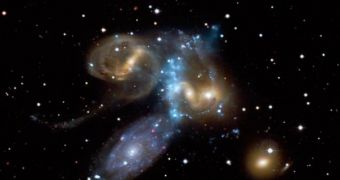In an international cooperative effort, experts managing the Chandra X-Rays Observatory, belonging to the American space agency NASA, and the optical Canada-France-Hawaii Telescope, on top of the Mauna Kea volcano, in Hawaii, have taken one of the most complex and revealing pictures to date of the Stephan’s Quintet formation, located some 280 million light-years away from Earth. Despite the fact that, in theory, there are supposed to be five galaxies in a quintet, the actual pile-up, in which these formations are slamming into each other at enormous speeds, is made up of only four.
The new picture, which combines X-ray imaging with optical observations by the Hawaii telescope, depicts a large galactic merger. There are four galaxies converging to a single point in space, and the collision is either caused by their own gravitational pull, or because they are riding a stream of dark matter. While three of them converge to the location, the fourth, shown towards the lower center part of the image, as the bright, blue spiral one, is simply ripping its way through them all, at the mind-boggling speed of two million miles per hour.
In the center of the image, the blue halo is actually the piece of image that Chandra snapped, which features swaths of X-rays, generated as countless solar systems are being destroyed by the highly energetic collisions. As stars explode or are ripped apart by the unimaginable forces that are created when two galaxies collide, they give off large amounts of X-rays and gamma-rays, which can be easily observed using space-based telescopes. The three other yellowish galaxies were all imaged by the CFH Telescope.
The fifth galaxy, towards the lower right part of the image, is actually not involved in the collision at all, Wired informs. It is located 40 million light years away from Earth, in the foreground, and therefore spins some 240 million light-years away from the colliding cluster. But, when astronomer Edouard Stephan first discovered the mash-up, back in 1877, the technology to differentiate the distances between two points at such long distances was still in its infancy, so the formation was named a quintet.

 14 DAY TRIAL //
14 DAY TRIAL //